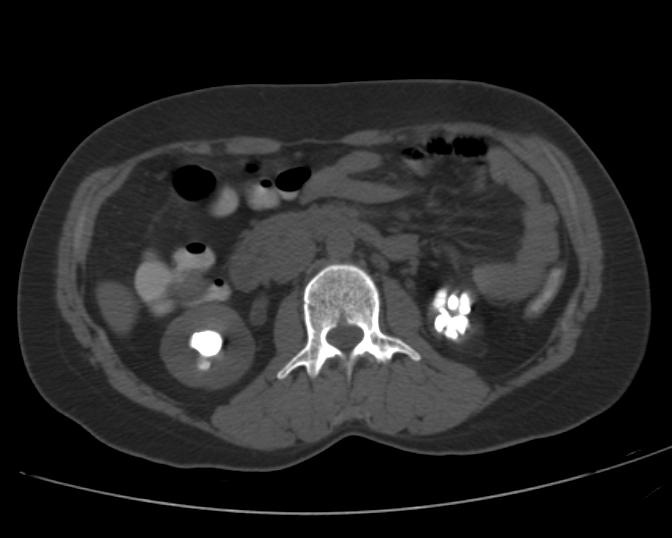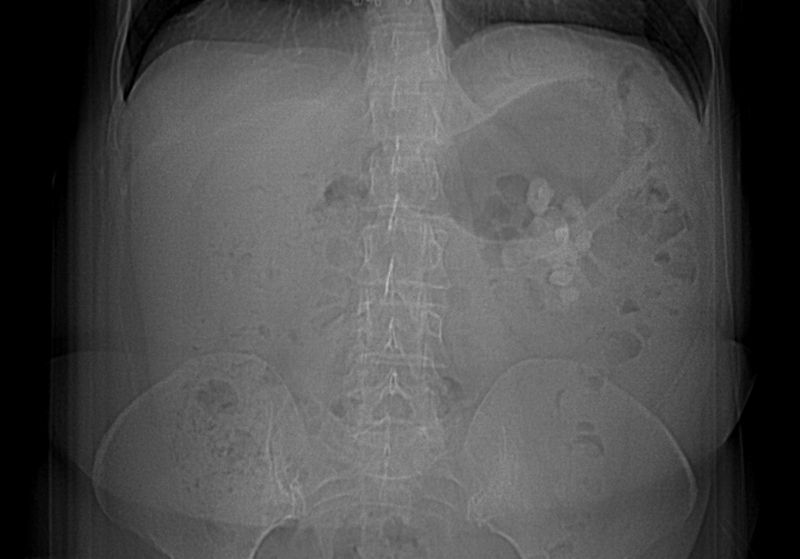Kidney stone CT: Difference between revisions
No edit summary |
No edit summary |
||
| (4 intermediate revisions by 3 users not shown) | |||
| Line 1: | Line 1: | ||
__NOTOC__ | __NOTOC__ | ||
{{Kidney stone}} | {{Kidney stone}} | ||
{{CMG}} | {{CMG}}; {{AE}} {{ADS}} | ||
==Overview== | |||
Abdominal and pelvic CT scan is helpful in the diagnosis of nephrolithiasis. Findings on CT scan diagnostic of nephrolithiasis include radiopacity showing the location, density and composition of stones [[calcium oxalate]] +/- [[calcium phosphate]]: 400-600 HU, [[struvite]] (triple phosphate): usually opaque but variable, pure [[calcium phosphate]] 400-600 HU, [[uric acid]]: 100-200 HU and [[cystine]]: opaque. | |||
==CT scan== | |||
*Abdominal and pelvic CT scan may be helpful in the diagnosis of nephrolithiasis. Findings on CT scan diagnostic of nephrolithiasis include: | |||
**Radiopacity showing the location, density and composition of stones: | |||
***[[Calcium oxalate]] +/- calcium phosphate: 400-600 HU | |||
***[[Struvite]] (triple phosphate): usually opaque but variable | |||
***Pure [[Calcium phosphate|calcium phosphate:]] 400-600 HU | |||
***[[Uric acid]]: 100-200 HU | |||
***[[Cystine]]: opaque | |||
'''Patient #1: CT Image Demonstrates a Jackstone Calculus''' | '''Patient #1: CT Image Demonstrates a Jackstone Calculus''' | ||
| Line 38: | Line 49: | ||
</gallery> | </gallery> | ||
==References== | ==References== | ||
{{ | {{Reflist|2}} | ||
{{WH}} | {{WH}} | ||
{{WS}} | {{WS}} | ||
[[Category: (name of the system)]] | |||
Latest revision as of 07:07, 22 June 2018
|
Kidney stone Microchapters |
|
Diagnosis |
|---|
|
Treatment |
|
Case Studies |
|
Kidney stone CT On the Web |
|
American Roentgen Ray Society Images of Kidney stone CT |
Editor-In-Chief: C. Michael Gibson, M.S., M.D. [1]; Associate Editor(s)-in-Chief: Amandeep Singh M.D.[2]
Overview
Abdominal and pelvic CT scan is helpful in the diagnosis of nephrolithiasis. Findings on CT scan diagnostic of nephrolithiasis include radiopacity showing the location, density and composition of stones calcium oxalate +/- calcium phosphate: 400-600 HU, struvite (triple phosphate): usually opaque but variable, pure calcium phosphate 400-600 HU, uric acid: 100-200 HU and cystine: opaque.
CT scan
- Abdominal and pelvic CT scan may be helpful in the diagnosis of nephrolithiasis. Findings on CT scan diagnostic of nephrolithiasis include:
- Radiopacity showing the location, density and composition of stones:
- Calcium oxalate +/- calcium phosphate: 400-600 HU
- Struvite (triple phosphate): usually opaque but variable
- Pure calcium phosphate: 400-600 HU
- Uric acid: 100-200 HU
- Cystine: opaque
- Radiopacity showing the location, density and composition of stones:
Patient #1: CT Image Demonstrates a Jackstone Calculus
Patient #2: CT Images Demonstrates Bilateral Staghorn Calculi
Patient #3: CT Images Demonstrates Left-sided Staghorn Calculi




